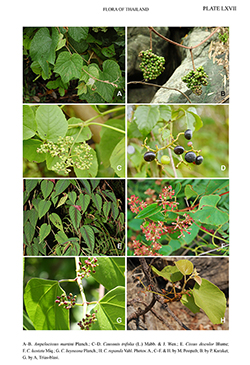e-Flora of Thailand
Volume 14 > Part 4 > Year 2020 > Page 596 > Vitaceae > Ampelocissus
9. Ampelocissus martini Planch.wfo-0000531545
in A.DC. & C.DC., Monogr. Phan. 5 (2): 373. 1887; Gagnep., Bull. Soc. Hist. Nat. Autun 24: 22. 1911; in Lecomte, Fl. Indo-Chine 1: 992. 1912; Kerr, Bull. Misc. Inform. Kew 1911: 31. 1911; Craib, Fl. Siam. 1: 303. 1926; Gagnep. in Humbert, Suppl. Fl. Indo-Chine 1: 909. 1950; Suess., Nat. Pflanzenfam. 20d: 305. 1953; J.Wen, L.M.Lu & Boggan, Philipp. J. Sci. 142: 230. 2013.— Vitis martini (Planch.) Ridl., Fl. Malay Penins. 1: 471. 1922. Plate LXVII: A–B.
Accepted Name : This is currently accepted.
Synonyms & Citations :
Description : Woody climber. Stem erect, cylindrical to 1.25 cm diam., slightly ridged, hairy with 2 types of hairs: pale arachnoid hairs and dark erect glandular hair, 1.5–4(–6) mm long, branched; tendrils bifurcate, borne beside inflorescence at tip of a common peduncle, tendrils peduncle straight 20–130 by 0.5–3 mm, then bifurcating and each branch to 40–80 by 0.3–0.5 mm, hairy with 3 types of hairs: 2 hair types as in stem plus short yellowish papillae 0.1–0.15 mm long. Leaves simple; petiole 20–170 by 0.5–1.5 mm, densely hairy as stem; leaf blade cordate to pentagonal, slightly to deeply 3–5–(–7) lobate sometimes becoming palmatisect and sometimes almost entire, 5–22 by 5–24 cm, base cordate to auriculate, margin dentate with teeth with a mucronate apex, apices acute to rounded, adaxial side sparsely hairy with arachnoid hairs and some dark erect glandular hairs especially on veins, abaxial side densely ferruginous arachnoid with scattered dark glandular hairs and with veins protruding densely covered by glandular hairs, 3–7 main veins, secondary veins 2–6 pairs. Inflorescence a compact, pyramidal thyrse, mostly bearing a tendril, ramified with numerous branches, uppermost inflorescence axis covered by flowers, 4–14(–17) by 2–8(–13) cm; common peduncle to 3–14(–19) cm, primary inflorescence peduncle 1–2 cm long, both densely hairy with hairs as stem, flowers sessile or subsessile. Buds cylindrical to clavate, 1.5–2 by 0.75–1.5 mm, apex mostly truncate. Calyx cupuliform, entire, sinuate, 0.5 by 1–1.5 mm, glabrous. Petals 4–5, ovate, 1.25–1.5 by 0.5–0.75 mm, spreading at anthesis, apex cucullate, glabrous. Stamens 4–5; filaments flattened, 0.75–1.2 mm long, broadening at base; anthers elliptic, 0.4–0.6 mm long, medifixed; pollen yellow, abundant. Disc with 4–5 vertical ridges, 0.4–0.6 by 0.6–0.8 mm, glabrous. Style slightly conical, 0.2–0.3 by 0.2–0.3 mm, stigma inconspicuous. Fruit globose to subellipsoid, 1 by 0.8–1 cm, base attenuate. Seeds 2–4, oblong, 5–9 by 3–6 mm, abaxial medial hilum narrowly elliptic to elliptic, adaxial raphe protruding forming 2 sides.
Thailand : NORTHERN: Mae Hong Son (Mae Sariang), Chiang Mai (Doi Chiang Dao, Doi Suthep, Doi Chang Liang), Chiang Rai (Doi Luang NP), Lampang (Doi Khun Tan NP, Chae Son NP), Phitsanulok; NORTH-EASTERN: Khon Kaen; EASTERN: Chaiyaphum (Phu Khieo), Nakhon Ratchasima (Ban Chum Saeng); SOUTH-WESTERN: Ratchaburi, Phetchaburi; CENTRAL: Saraburi (Sam Lan, Muak Lek, Ban Khrua), Krung Thep Maha Nakhon (Bangkok); SOUTH-EASTERN: Chachoengsao (Khao Chakan Arboretum), Chon Buri (Si Racha, Si Chang Island); PENINSULAR: Nakhon Si Thammarat (Thung Song, Khao Luang NP).
Distribution : Hong Kong, Laos, Vietnam (lectotype), Cambodia, Malaysia (Peninsula – lectotype of Vitis barbata var. trilobata), Borneo, the Philippines.
Ecology : Edges of forests and rivers, disturbed areas, 0–1,100 m alt. Flowering: April–July; fruiting: June–October.
Vernacular : Khruea i koi (เครืออีโกย)(Nakhon Ratchasima); thao priao (เถาเปรี้ยว)(Bangkok); thao wan khon (เถาวัลย์ขน)(Ratchaburi); som kung (ส้มกุ้ง), som op (ส้มออบ)(Nakhon Si Thammarat); som kui (ส้มกุ่ย)(Saraburi).
Uses: Sap edible, eaten with salt by the natives; the berries are edible (Gagnepain, 1912).

